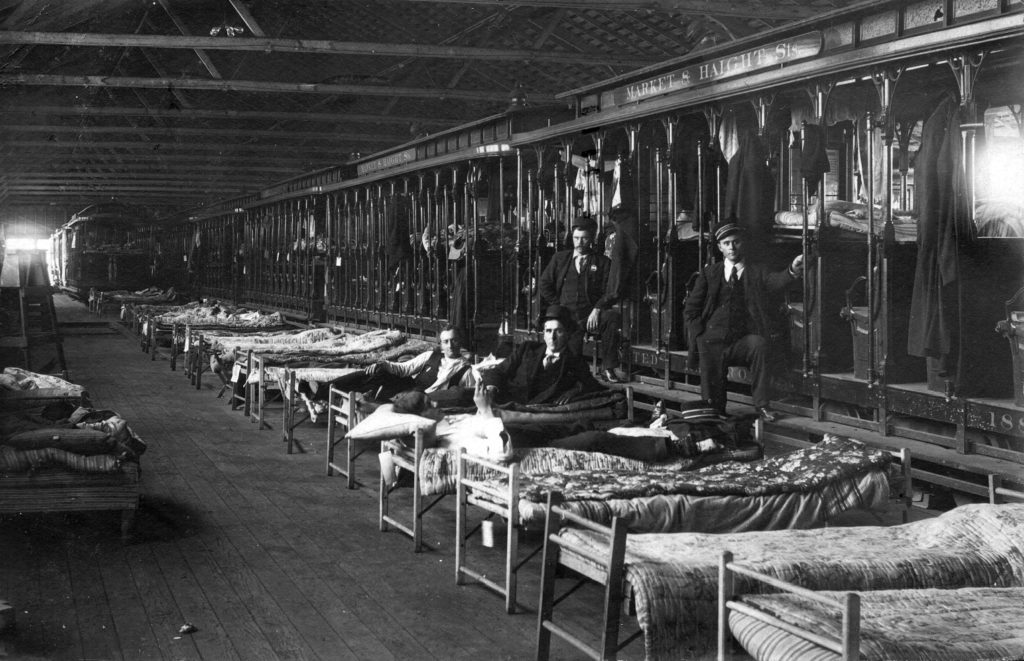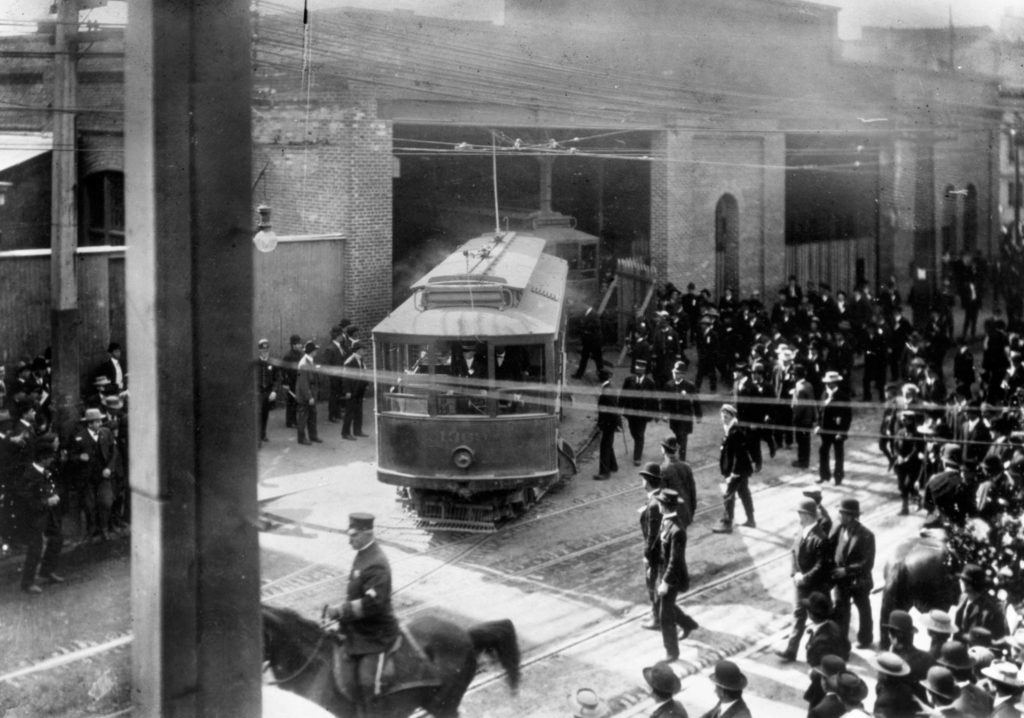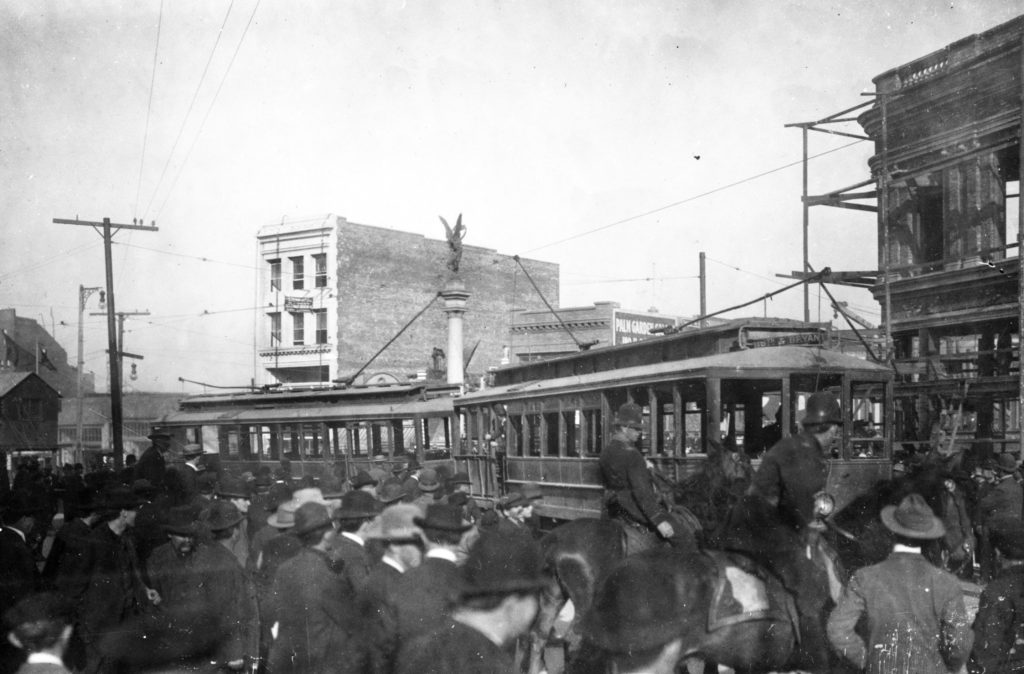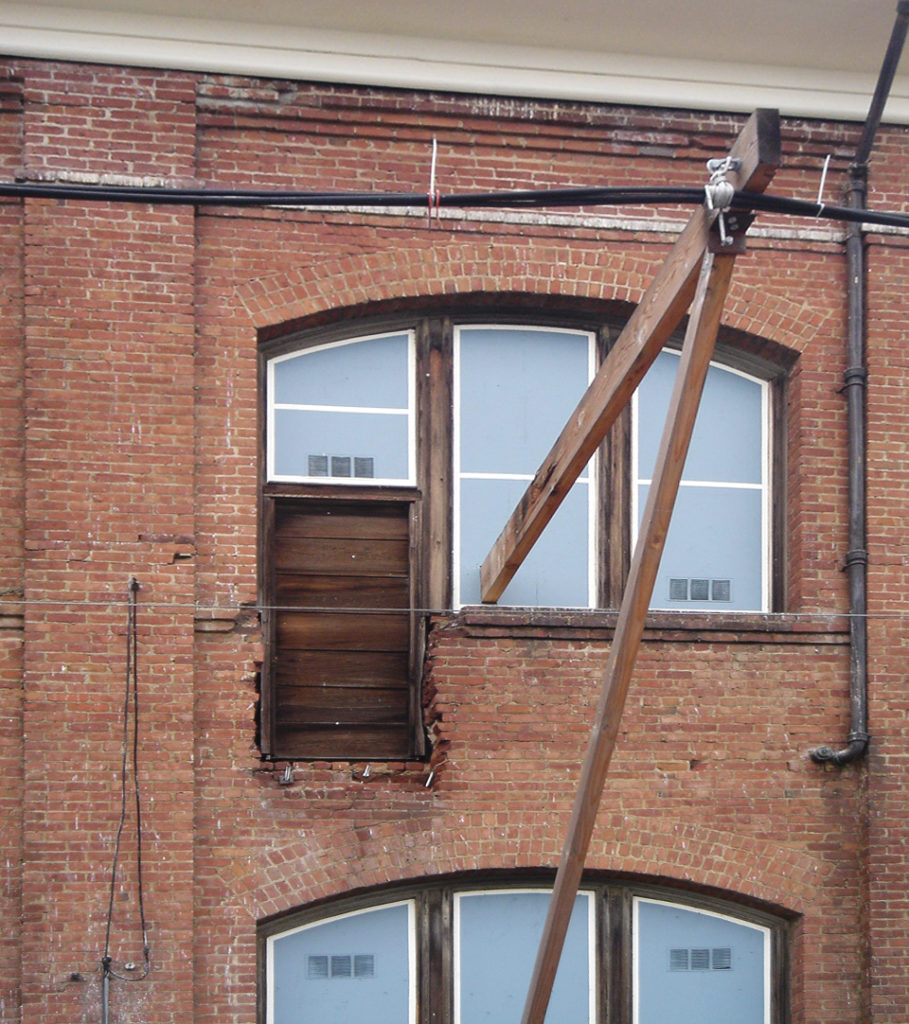San Francisco has long been in the forefront of workers’ rights. This history extends back into the 19th century, but it was an event just one year after the San Francisco earthquake and fire of 1906 that shook the city all over again – one of San Francisco’s bitterest strikes that shaped the future of streetcar service in San Francisco and influenced the City’s labor movement in general.

This strike began with what the press called the ‘San Francisco Streetcar War’. The police chief issued a ‘shoot to kill order’ if police were fired upon. The Governor threatened to send troops into San Francisco. Once again San Francisco ground to a halt.
Back then transit service in San Francisco had been largely consolidated under a private company named United Railroads (URR), owned by Baltimore utility interests, and led by its president, Patrick Calhoun. In the wake of the earthquake and fire, Calhoun saw an opportunity to break a political stalemate that had prevented him from converting his cable car lines on Market Street to faster, higher–capacity streetcars. To do so, he allegedly bribed the entire Board of Supervisors to gain a permit to install overhead wires on Market for streetcar operation. (A 22–month trial on this charge ended with a hung jury, and Calhoun went free.)
As he was working to permanently convert Market Street to streetcars after the earthquake and fire, Calhoun was faced with a strike in August 1906, his workers seeking to renegotiate their contract due to the changed working conditions and wages in the booming reconstruction period. They also sought an eight–hour day instead of the then–current ten. The strike went to an arbitration committee after ten days with a wage increase, but no change in hours. The arbitration lasted until the contract ran out in May 1907.


But worker resentment grew, and on May 5, the carmen (as they were then called) of URR went on strike, again seeking an eight–hour day, plus a 20% boost in daily pay (from $2.50 to $3.00). This time there would be no quick settlement. The stage had been set by the strike the previous autumn when URR brought in crews hired by an experienced strikebreaker named James Farley. By late Spring 1907, neither the rank–and–file nor management were in a mood to compromise. From contemporary accounts, it appears likely that the union’s secretary-treasurer, James Bowling, had been bribed to foment the strike, while union leadership urged a more cautious approach. Bowling never said who, but a strike did present the opportunity for United Railroads to eradicate all prospects of a union.
Once again URR brought in armed ‘Farleyites’ who barricaded themselves into well–provisioned car barns. Tensions mounted as strikers and sympathizers massed outside waiting for the first car to pull out.
Late Tuesday morning, May 7, 1907, the doors of the fenced yard on Turk behind the still–existing Turk & Fillmore powerhouse swung open and revealed a red ‘car of mystery’—actually a streetcar built to transport race horses between racetracks on car lines. The car proceeded only 300 feet under a hail of bricks and insults before being blocked by sympathetic teamsters. The crew abandoned the car and retreated to the safety of the car barn.
At 3:25 in the afternoon, around the corner on Fillmore Street, six cars pulled out of the Turk & Fillmore car barn. Two URR inspectors and four of Farley’s strikebreakers wearing pistols manned each car. When pelted again with rocks and bricks, Farley’s men opened fire on the crowd. A running fight continued down Turk Street all the way to Market & Mason with missile–throwing strike sympathizers following in an automobile and strikebreakers shooting at their pursuers.
The first two cars were stopped at Mason, Turk & Market Streets and the strikebreakers opened fire on the crowds and police alike. The battle ended when they fled after running out of ammunition.
The next two cars only reached Hyde Street where police protected the crews after they were overrun by the angry mob. The two last cars out of the barn were commandeered shortly by strikers and driven back up Turk Street filled with triumphant striking motormen and conductors. The switch was thrown toward the yard behind the powerhouse where the ‘car of mystery’ had emerged and strikers plowed the car into the closed gate. As car No. 1359 broke through, the gunmen inside the facility opened fire, seriously wounding strikers, passersby and bystanders.
By the end of ‘Bloody Tuesday’, a chauffeur lay dead and two striking carmen were fatally wounded. Two other strikers were shot along with two policemen and a dozen bystanders. Central Emergency Hospital was crowded with injured and wounded from both sides. Police arrested twelve strikebreakers and charged them with murder or attempt to commit murder. Several rock throwers were also in custody.
The next day, cars were escorted out of the barn by mounted police. The strike dragged on as public support varied on different streetcar lines depending on whether the neighborhood was predominantly pro–labor. On September 9th, the Strike Committee called off the boycott in an effort to raise ridership so that strikers would have to be called back to work. The strike officially ended on September 12th, 1907.
Here’s how San Francisco rail historian Charles Smallwood chronicled it in his wonderful book, The White Front Cars of San Francisco:
“Just how serious the situation became was clear in these notations from the 29th and Mission Car House daybook:
“‘July 20, 8:45 p.m. — Conductor Kawag and Motorman S. Feller were shot at 29th and Noe and then the rioters let car go down the hill to 29th and Mission where it jumped the track and ran into a candy store and toggery store completely smashing the fronts of both stores. The car was a total wreck.’
“‘October 19 — Riot on car #1575, run 9, Polk-Larkin Line, Conductor Brown and Motorman Purcell both beaten. In protecting themselves they fired several shots hitting three rioters, two of whom were killed.’”
The fact that the strikebreaking motorman and conductor were armed as late as October on the Polk-Larkin line speaks volumes about the continuing ugliness and danger of the post–strike environment. Smallwood notes that 3,539 streetcar windows were shattered by missiles thrown by strikers and their supporters. (One wonders who kept such a meticulous count.) It is estimated that the railroad lost $1.5 million in revenues. Much more seriously, as many as 32 men may have been killed, and over a thousand were wounded in the violence.

To the extent that there was a ‘winner’ in this confrontation, it was the company, for the union finally called off the strike after more than four months and the desertion of 250 strikers back to their jobs. But rancor and bitterness persisted for years. Many observers of the time believed that the labor practices of the company, coupled with its alleged bribery and generally arrogant attitude, contributed to the movement for a new city–owned streetcar operation to provide some competition and to serve new neighborhoods underserved by URR. This movement, of course, was successful, resulting in the opening of the Municipal Railway in 1912.
There was another strike at URR in 1917, even more bitter if possible. It included the cutting of a door into the upper floor brickwork of the Geneva Car House to allow ‘scab’ workers domiciled there to reach their streetcars without having to walk past strikers on Geneva Avenue. (This time around, the streetcar windows were covered by wire mesh. ) That door, by the way, is still visible today from the adjoining ladder–track storage area in what’s now Cameron Beach Yard, home of Muni’s historic streetcars. The Car House building itself will be renovated as a community center, as the adjoining powerhouse already has been.
Perhaps the ultimate payback for all this came in 1944, when San Francisco voters finally approved a measure to buy the successor to URR—Market Street Railway Co., for which our organization is named—and consolidate it with Muni. Both organizations were Union Shops by this time.
Our nonprofit has always honored the workers who keep San Francisco’s transit vehicles on the street. Labor Day is an annual reminder of what America owes all working people. In that regard, every day should be a day to honor labor.
By Grant Ute, San Francisco Railway Archive, and Rick Laubscher, Market Street Railway
If you like our exclusive content, please consider even a small donation to help our nonprofit.
Although I have been aware of the URR strikes, this is absolutely the best account of those strikes that I have ever read.